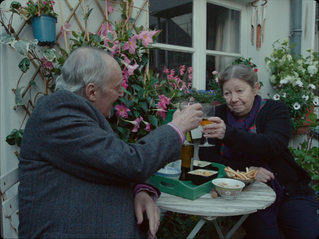Three Colours: Blue
- Isobel Wise
- Feb 5, 2021
- 2 min read
Krzysztof Kieślowski, 1993

In the hands of Krzysztof Kieślowski, the camera is awarded sentience. It forges a path intent on capturing the elusive inner life of its subject, the candid sincerity of fleeting expressions and subconscious habits. It longs to see individuals as they are when they are alone, lingering on that not privy to any other observer. In Three Colours: Blue, the way Kieślowski examines the grief of its protagonist implies that his camera does not merely ponder her bereavement, but in a way that seems entirely human, feels it also.
Julie (Juliette Binoche) wakes in a hospital, bruised and dazed following a car accident. Reeling from the information that the crash killed her husband and child, she attempts suicide but finds she cannot. In lieu of this inability to take her own life, and her reluctance to live in a world without her family, Julie drifts into a personal limbo. The car crash itself is shot without bravado; no explosions, no drama. The deaths of the renowned composer and his young daughter are not unjust, cruel, sacrificial, but mere chance; unfortunate and plausible, Kieślowski’s most-favoured muse. With no-one to blame, and no-one to live for, Julie procures what she believes crucial: complete anonymity. To the best of her ability she purges herself of all possessions—her family home, contacts, memories, responsibilities—and rents herself an apartment within which she can aimlessly exist in a state of self-denial. Her grief is not explicit, never verbalised, but is discerned most intimately through this facade of impassivity. Self-inflicted ostracisation is preferred to an outpouring of articulated agony; “Why are you crying?” Julie asks, “because you are not” her maid responds.

Allowing herself neither company nor pleasure, Julie surrenders to her grief as both casualty and survivor. Haunted by the colour blue, painful associations overwhelm her, conjuring orchestral perforations throughout the film. Zbigniew Preisner provides a score that punctuates, turning the screen black as if momentarily deafening Julie with its onslaught of melody. In tandem, colour and sound figure supernaturally here, given an almost metaphysical authority over the rhythm and tone of the film. Blue light awakens Julie, the colour following her in the form of lollipop wrappers, binders, chandeliers, and wallpaper, only totally obscured by the wall of black each thunderous excerpt of noise commands. Even the swimming pool, her lagoon of cerulean isolation, is invaded by the abrupt impertinence of Preisner’s musical fragments. However unnatural these powers may seem, it is through Kieślowski’s intimate examination of Julie’s inner life that they are given credence. Colour does more than exist in the realm of the aesthetic where it is perennially inobtrusive to the action, and is presented as the guide of Julie’s physical and emotional reactions. The music also refuses to be supplementary, actively participating like any other diegetic sound.









Comments